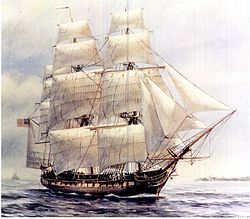

In sailing, reefing is the practice of reducing the area of a sail to preserve a sailing vessel's stability in strong winds. This is usually achieved by folding or rolling one edge of the canvas in on itself and attaching the unused portion to a spar or a stay. Restoring full sail area is termed shaking out a reef. [1]
Contents
Whereas fore-and-aft rigged vessels store the unused portion of the sail on a boom (below the sail), square-rigged vessels stow the unused portion on a spar above the sail. Reefing may occur by rolling the sail around its luff or foot, either on a rotating stay or within a spar.


